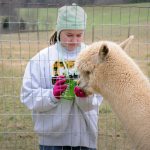Alpaca FAQ
Alpaca FAQ
We here at Rita Dee Alpacas love to get, and frequently receive, questions from future farmers interested in raising alpacas or maybe even just adding a few alpacas to their farm or country estate. So we decided to put a list of the most common questions we receive. If you don’t see your question here, email us! We’d love to hear from you. rita@ritadeealpacas.com
How Much To Do Alpacas Cost?
Like all things in life, you get what you pay for. Animals with top quality fleece and great pedigrees can be quite expensive and cost tens of thousands of dollars. The record auction price was over $600,000! At the opposite end, an unwary buyer might find an older animal with serious health issues on craigslist for free. Generally speaking you can expect to spend from $1500-3000 for a quality, female alpaca you could breed to form the “foundation” of your herd. Quality males are typically slightly less.
Is Alpaca Fleece Better Than Wool?
Alpaca fleece is much finer than wool, and this heavier coarseness found in wool is the reason wool irritates and feels scratchy to most people. Alpaca fiber is also considered lighter, warmer, and stronger than wool though these qualities depend heavily on the type of yarn and weave/knitting. Probably most importantly for folks, alpaca fleece does not contain lanolin like wool does, so is tolerated by people with sensitive skin better than wool. Virtually everyone overwhelmingly prefers wearing alpaca over sheeps’ wool.
What Is The Value Of The Fleece?
Most folks can expect to make about $100 per animal per year on fleece with minimal investment in the processing of that fleece. They can expect much more if the farmer adds value to the fleece by making final, finished products out of the fleece(spinning and knitting themselves); or less if they simply sell the “raw” fleece outright to fiber mills. The important thing here to realize is revenue is limited by your own creativity.
Do Alpacas Require Much Care?
Alpacas are an easy animal to raise and care for and typically require less care than most farm animals. The regular care involves trimming toenails and, if the farm so chooses, a regular immunization program. Alpacas breed and birth easily when compared to other livestock and recover from the occasional illness or injury easily. They are certainly much less work than sheep, goats, cattle or horses. But like all living, breathing creatures, you will have to occasionally care for the sick animal, treat a wound, give medicine, and maintain teeth, nails and shear fleece.
When Do You Shear The Animals?
Because their fleece is so warm, heat stress is concern here in North Carolina. So we shear them once a year after the danger of freezing temperatures has passed but before the weather gets above 80 degrees on a regular basis. Here in northwest part North Carolina, that means we shear the second or third week in April.
Can You Train Alpacas?
Certainly! All alpacas will train to a halter, and some are so well mannered that we use them for therapy animals at nursing homes and schools. They are generally calm, curious animals without a trace of animosity or mischievous behavior. Like all animals, they have their own personalities and some require more work than others to train. But you would be hard pressed to find a farm animal that, as a group, are better behaved and safe to be around.
What Type Of Fences Do Alpaca Require?
Alpacas do not challenge or test fences, and the fencing requirement to contain them is quite low. They are not the escape artists like goats, nor will they destroy fences like sheep or cattle. However, the main problem in most farming communities is the presence of coyotes and dogs. Unfortunately these predators will chase, harass and even injure and kill alpacas if they can get into your pastures. Therefore, we recommend a 5 foot high 4″x2″ mesh “no climb” fence for your pastures. Red Brand fencing makes an excellent product.
What Type Of Barn Do You Need?
Because their fleece protects them so well, here in North Carolina they only need to be able to access shelter in the event of precipitation and to protect them from the worst of the sun in the summer. They don’t require stalls in the barn or any special insulation, flooring or containment system. We recommend an open barn plan with three enclosed sides and an open side that is not open to the prevailing winter winds. As for size, 75 square feet per animal is usually adequate. We also recommend fans for the summer.
